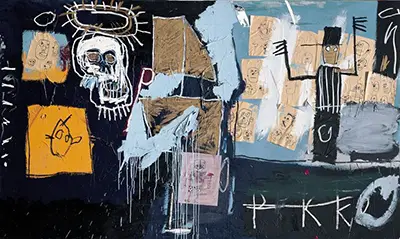Theme of the Slave Auction
The painting illustrates a clear blue ocean with several head drawings on brown papers attached to it. This could symbolize how according to history, slaves were taken from their home land and shipped across the ocean to foreign lands, where they would work as slaves for the rest of their lives. The brown papers with the head drawings could represent the ships that carried thousands of slaves across the ocean. A closer look at the head drawings suggests that some of the heads could represent children, due to the smaller size. This indicates that in the past, slave traders would not only take adults as slaves, but they would also take young children as well.
There is a tall figure dressed in black looming over the blue waters. Its arms are stretched above its head, and there are white stripes on the upper part of its body. The combination of black and white on the figure could symbolize that the imprisonment or slavery that awaited the slaves on the other side of the waters. The tall black figure could represent the power or nation responsible for taking the slaves away from their original homeland, shipping them across the ocean to foreign lands, and selling/auctioning them away. The left side of the painting appears to have several patches of land represented by the brown color. The land appears to be divided by blue, white, and red colors. The colors could represent most of the colonial countries in history, because of the color of their national flags today.
Basquiat's style in Slave Auction
The style used by Jean-Michel Basquiat to create the Slave Auction art appears to be a combination of wild strokes brushes, unique colors, and extraordinary pencil work. The graffiti style used to depict the theme, and the attractive color schemes work together to create this ingenious abstract piece of work. The symbolic painting style that Jean-Michel Basquiat used conveys street art and neo-expressionism. As stated earlier, this incredible piece of art was created in 1982, and could currently be in UCCA Center for Contemporary art in Beijing where most of Jean-Michel Basquiat's artwork is displayed. Shortly after his death in 1988, the New York Times listed Basquiat as one of the most influential your black artists to achieve national recognition.


